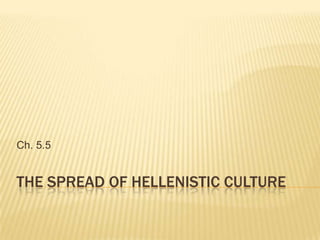
Ch 5.5 -the spread of hellenistic culture
- 1. The Spread of Hellenistic Culture Ch. 5.5
- 2. Hellenistic Culture in Alexandria After Alexander’s death, a vibrant new culture emerged. Greek (Hellenic) culture blended with Egyptian, Persian, and Indian influences. Koine (koy•NAY) Means common in Greek. Enabled educated people and traders from diverse backgrounds to communicate in cities throughout the Hellenistic world.
- 3. Trade and Cultural Diversity African city of Alexandria became the foremost center of commerce and Hellenistic civilization. Ships from all around the world docked here. By 300 B.C., had over 500,000 residents.
- 4. Alexandria’s Greatest Attractions Both residents and visitors admired Alexandria’s great beauty. Alexandria’s museum and library Library contained over 500,000 papyrus scrolls for research and reading. Included many masterpieces of ancient literature One of the greatest attractions was The Pharos
- 5. Pharos 400 feet tall
- 6. Science and Technology During the Hellenistic period, the center of scholarship gradually shifted away from Athens. Made significant discoveries in astronomy and mathematics.
- 7. Astronomy Aristarchus (AR•ih•STAHR•kuhs) of Samos estimated that the sun was at least 300 times larger than the earth. (It’s actually about 1.3 million times larger) Concluded the Earth revolved around the Sun, which went against Ptolemy’s idea ( the common view of the time) that the Sun revolved around the Earth. This view was held for the next 14 centuries, until Galileo discovered that it didn’t.
- 8. Eratosthenes (EHR•uh•TAHS•thuh•NEEZ) closely calculated the earth’s true size. He skillfully used geometry to compute the earth’s circumference at 24,662 miles. The earth’s circumference is actually 24,860 miles. He was less than 1% off. Not bad….
- 9. Mathematics and Physics Euclid (YOO•klihd). His best-known book, the Elements, contained 465 carefully presented geometry propositions and proofs. It is sometimes said that only the Bible has been more widely used and studied. Euclid’s work is still the basis for courses in geometry.
- 10. Law of the Lever Archimedes (AHR•kuh•MEE•deez) correctly estimated the value of pi (π ). Archimedes also explained the law of the lever and invented the compound pulley to lift heavy objects. A V O I C E F R O M T H E PA S T Archimedes took a . . . ship . . . which had just been dragged up on land with great labor and many men; in this he placed her usual complement of men and cargo, and then sitting at some distance, without any trouble, by gently pulling with his hand the end of a system of pulleys, he dragged it towards him with as smooth and even a motion as if it were passing over the sea. PLUTARCH, Parallel Lives: Marcellus
- 12. Believed to be over 100 feet tall. Legend says his legs straddled the harbor, but this would have been impossible given the estimation of his size. One of the seven wonders of the ancient world, the Colossus of Rhodes was toppled by an earthquake about 225 B.C. Later, the bronze was sold for scrap.
- 13. Hellenic Decline By 150 B.C., the Hellenistic world was in decline. A new city, Rome, was growing and gaining strength. Through Rome, Greek-style drama, architecture, sculpture, religion, and philosophy were preserved and eventually became the core of Western civilization.
